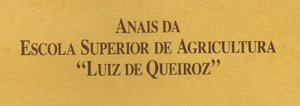Resumo
Irish potato tubers imported from Holland and Germany were planted at the Instituto Agronômico Experiment Station, Campinas, in April, 1955. At digging time, in July, 1955, the tubers were found to be injured by nematodes belonging to the genus Ditylenchus. No visible symptoms were found on the plants during the growing season, since the nematodes did not attack the stems. However, prevailing weather conditions from April to July were not favorable for nema activities, with low temperature and rain precipitation. Therefore, it does not seem safe to assume that, as a rule, the nemas do not attack buds and stems, for further observations may reveal such an occurrence, as it has been reported in the literature. The injury was characterized by spots consisting of decaying brown tissue, the nematodes being found mainly between this and the uninjured tissue. Larvae and adults occurred simultaneously. Fourteen different potato varieties were attacked by the nematodes, the percentage of disfigured tubers ranging from 6 (vars. Irene, Barima and Tedria) to 38 (var. Stamm 456). Studies en the morphology cf the parasites disclosed that two different Ditylenchus forms were present, with Apheten-chus sp. and Aphelenchoides sp. associated with them. The writers have not yet drawn a final conclusion about the identification of the Ditylenchi. However, it was clearly seen that no form can be identified either with D. dipsaci or with D. destructor. Both forms have lateral fields made up of 6 incisures, what separates them from D. dipsaci. On the other hand, measurements as well as some details in the organization of the oesophagus make the identification with D. destructor quite impossible. As far as the origin of the parasites is concerned, the fact that they could not be determined either as D. dipsaci or as D. destructor emphasizes the possibility of being two native species, not introduced with the tubers imported.
Adiel Paes Leme ZamithI; Luiz Gonzaga E. LordelloI; O. J. BoockII
IEscola Superior de Agricultura "Luiz de Queiroz" Universidade de S. Paulo Piracicaba
IIInstituto Agronômico do Estado de S. Paulo Campinas
SUMMARY
Irish potato tubers imported from Holland and Germany were planted at the Instituto Agronômico Experiment Station, Campinas, in April, 1955. At digging time, in July, 1955, the tubers were found to be injured by nematodes belonging to the genus Ditylenchus.
No visible symptoms were found on the plants during the growing season, since the nematodes did not attack the stems.
However, prevailing weather conditions from April to July were not favorable for nema activities, with low temperature and rain precipitation. Therefore, it does not seem safe to assume that, as a rule, the nemas do not attack buds and stems, for further observations may reveal such an occurrence, as it has been reported in the literature.
The injury was characterized by spots consisting of decaying brown tissue, the nematodes being found mainly between this and the uninjured tissue. Larvae and adults occurred simultaneously.
Fourteen different potato varieties were attacked by the nematodes, the percentage of disfigured tubers ranging from 6 (vars. Irene, Barima and Tedria) to 38 (var. Stamm 456).
Studies en the morphology cf the parasites disclosed that two different Ditylenchus forms were present, with Apheten-chus sp. and Aphelenchoides sp. associated with them. The writers have not yet drawn a final conclusion about the identification of the Ditylenchi. However, it was clearly seen that no form can be identified either with D. dipsaci or with D. destructor. Both forms have lateral fields made up of 6 incisures, what separates them from D. dipsaci. On the other hand, measurements as well as some details in the organization of the oesophagus make the identification with D. destructor quite impossible.
As far as the origin of the parasites is concerned, the fact that they could not be determined either as D. dipsaci or as D. destructor emphasizes the possibility of being two native species, not introduced with the tubers imported.
Texto completo disponível apenas em PDF.
Full text available only in PDF format.
LITERATURA CITADA
- BLODGETT, E. C, 1943 Stem nematode on potato: a new potato disease in Idaho. Plant Dis. Reptr 27: 658.
- BOOCK, O. J., 1955 Variedades de batatinha Solatium tuberosum L. Comportamento de 58 variedades em experimentaçăo no Estado de S. Paulo. Escola Superior de Agricultura "Luiz de Queiroz", Tese, 103 pp., 3 ests.
- CARVALHO, J. C. de, 1953 Ditylenchus destructor em tubérculo-semente importado da Holanda. Rev. Inst. Adolfo Lutz 13: 67-74.
- GOODEY, T., 1956 The nematode parasites of plants catalogued under their hosts. Commonw. Agric. Bureaux, Inglaterra, 140 pp., rev. de J. B. Goodey e M. T. Franklin.
- KUEHN, J., 1888 Die Wurmfaeule, eine neue Erkrankungsform der Kartoffel. Zeitschr. Spiritusind. 11: 335.
- McCUBBIN, W. A., G. STEINER & outros, 1946 The potato rot nematode, Ditylenchus destructor Thorne. U. S. Dept. of Agriculture, mimeografado, 7 pp. 2 ests.
- QUANJER, H. M., 1927 En aaltjesziekte van de aardappelplant, de aantastingswijze en de herkomst van haar oorsaak, Tylenchus dipsaci Kuehn. Tijdschr. Plantenziekten 33: 137-172, ests. 9-13.
- THORNE, G., 1945 Ditylenchus destructor, n. sp. the potato rot nematode, and Ditylenchus dipsaci (Kuehn, 1857) Filipjev, 1936, the teasel nematode (Nematoda: Tylenchidae). Proc. Helminth. Soc. Washington 12: 27-34.
Ocorrência de nematódeos do gênero Ditylenchus em tubérculos de batatinha no Est. de São Paulo
Datas de Publicação
-
Publicação nesta coleção
28 Set 2012 -
Data do Fascículo
1956

